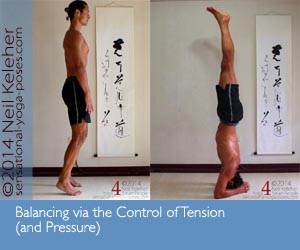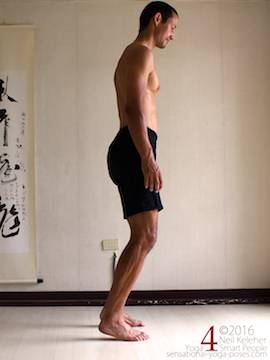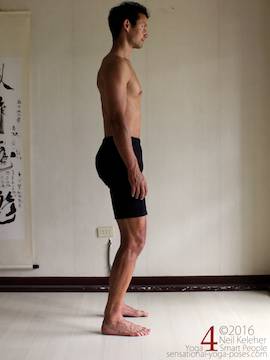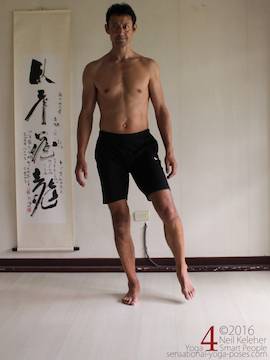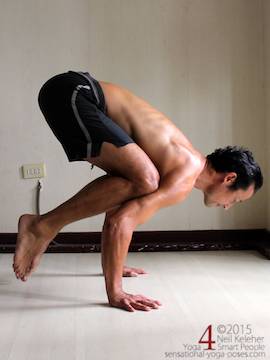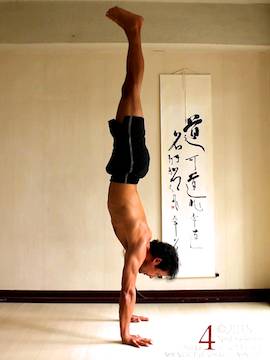Improve Balance with Yoga
By Stabilizing Your Foundation
How do you improve balance with yoga?
You can just practice yoga balance poses.
But if might help to understand that some poses are more challenging to balance in than others. How to you then progress balance poses, and what can you focus on to make improvements in your balance ability?
It helps if you first understand some basic principles of balancing. You can then work at improving balance with yoga.
Size of Foundation and
Height of Center of Gravity
When practicing balance, or yoga poses in general, the foundation is the part of our body in contact with the floor. The smaller the foundation a yoga pose has, the more difficult it is to balance in that pose. As an example, balancing on the fronts of the feet with heels lifted is harder than balancing with the feet flat on the floor. Balancing on the heels is harder yet.
One reason that balancing on the fronts of the feet is easier is that you can use your toes to help you balance.
Making Balance Easier (or Harder)
And this gives a clue to balancing on one foot. If you want to make balancing on one foot easier try using your toes to help. But even before you do that you can practice pressing your toes down while standing with weight even on both feet.
So does that mean that you should only practice balancing the easier yoga poses?
No.
Instead, if you have difficult balancing, improve balance in the easier yoga poses first. Then work towards the more difficult yoga poses. As an example, practice balancing on one foot with toes pressing down first, then try balancing without using your toes. Or try balancing on both feet with weight forwards so that toes press down, then try balancing on your heels with fronts of your feet lifted.
Balance While On Your Hands
Balancing on the hands in poses like handstand and bakasana is more difficult than balancing on the feet because the hands have a smaller surface area than the feet. But balancing on the hands in bakasana in easier than balancing on the hands in handstand for two reasons.
Not only is your center closer to the earth in bakasana, your shins are also resting on the backs of your arms so that your forearms and thighs bear your body weight without the knee of having to use the strength of the elbow joints, waist or knee joints.
In handstand, not only is the center of gravity very far away from the ground, the shoulders are also between the center and the ground. This means that the shoulders (and arms) have to be very stable in order to make balancing easier. If they aren't stable then the shoulders will move forwards or backwards, carrying the ribcage, pelvis and legs with them, and that will make staying balanced very difficult.
Improving Balance in Handstand
To improve balance in handstand first learn to control your shoulders so that you can use them to keep your ribcage where your want it to be. While the legs waving around can still make handstand difficult, I'd suggest that the shoulders are one of the first places to start to get better stability and control in handstand.
If you are unsure about being upside down in the first place, get comfortable with being upside down by using the L-Shape handstand against a wall.
Improving Balance In Standing Yoga Poses
How do you stay balanced while balancing on the fronts of your feet?
By aiming to keep even pressure in the toes and forefeet. If you feel your toes press down with greater pressure then this is an indication that your center has shifted forwards. Why, because the muscles at the bottom of our feet have to exert more tension to keep us upright. This increase in tension is a signal that your center has shifted.
The response is to boost the tension even more so that instead of just keeping your center where it is you actually push it back.
If your center shifts back then the toe tension will decrease. The muscles of the feet don't have to work so hard because our center has shifted rearwards. If the shift isn't too far then relaxing the toes further may be enough move your center forwards.
If your center has already moved somewhere behind the front of the foot then you are too late, you'll have to use some other means to get our center back over the fronts of the feet.
To improve balance in headstand yoga pose you can use the same principle. If your weight shifts forwards you'll feel it as an increase in downward pressure at the elbows. The response can be to press the elbows down with even greater pressure to shift your weight back. If your weight shifts backwards you'll notice it as a decrease in elbow pressure and/or an increase in pressure at the crown of our head.
Note that in both cases it is tension or its lack that helps us to feel our body. But it is also tension that can help us stabilize our body so that it is less likely to go off balance in the first place.
Further Reading
Can you actually shift your center of gravity relative to your body? Find out why and how in Yoga Balance Poses.
What is the one simple trick that most people miss when teaching or learning Arm Balances? Here's a more elegant approach to lifting your legs in arm balances such as crow pose, no jumping required!
For more on improving balance, including some simple balance exercises read Balance Basics.
Published: 2015 01 30
Updated: 2020 10 28
